No products in the cart.
May 12, 2024 9:37 am
May 12, 2024 9:37 am
In the rich tapestry of Norse mythology, Sleipnir stands out as one of the most extraordinary figures. Known as the eight-legged horse of Odin, Sleipnir embodies more than just a mythical creature; he is a symbol of supernatural speed, strength, and the mystical ability to navigate between worlds.
His unique attributes not only serve Odin, the god of wisdom and war, but also highlight the intricate relationships and magical elements that permeate the ancient stories of the Norse gods. As we delve into the origins, powers, and the immense cultural impact of Sleipnir, we uncover the depths of his significance in the old Norse tales and why he remains a fascinating subject of study and admiration today.
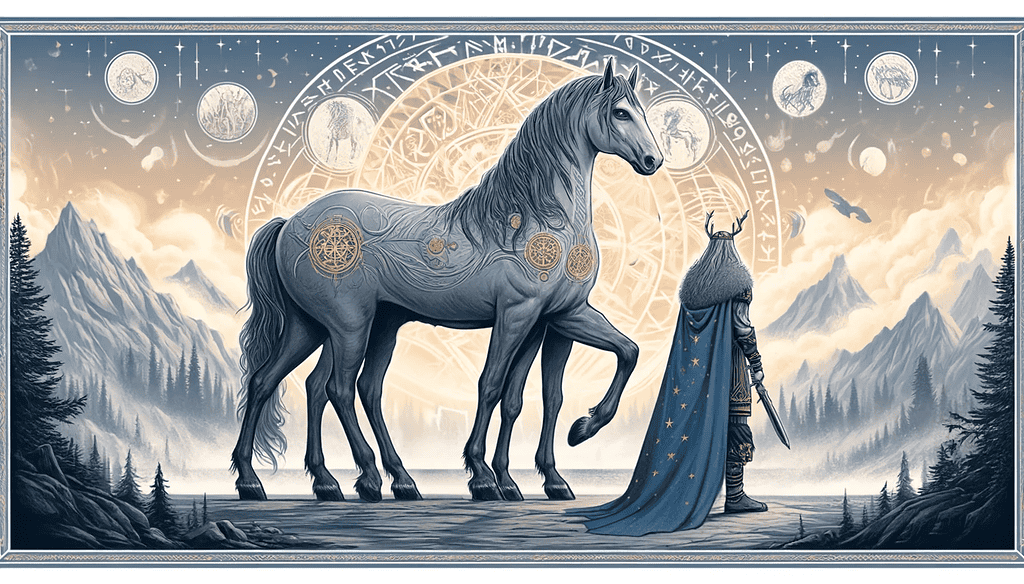
The saga of Sleipnir’s birth is intricately linked to a pivotal event in Norse mythology involving a mysterious builder, later revealed to be a giant.
He approached the gods of Asgard with a bold proposal: to construct a massive wall around their realm that would protect them from invaders. In return for this immense task, which he promised to complete within just three seasons, the giant demanded Freyja, the goddess of love and beauty, along with the sun and the moon.
The gods, both intrigued and wary, agreed to his terms with one critical condition — the wall had to be finished by the first day of summer without any human’s help. Using his mighty stallion, Svadilfari, the builder’s progress was unexpectedly swift, putting the gods at risk of losing their precious treasures.
Faced with the looming success of the giant, the gods turned to Loki to devise a plan to avert their loss. In a strategic move, Loki transformed himself into a beautiful mare, luring Svadilfari away from his duties.
This act of cunning effectively slowed the construction of the wall, ensuring that the builder could not meet the deadline. The disruption not only saved Freyja and the celestial bodies from being handed over but also led to the birth of Sleipnir, the result of Loki’s union with Svadilfari while in the form of the mare.
The birth of Sleipnir from such extraordinary circumstances underscores the themes of transformation and fluidity in Norse mythology.
Sleipnir, with his eight legs, is not just a physical marvel but also a symbol of mystical abilities and transcendent powers. His existence is a testament to the narrative that gods and creatures in Norse myths often embody multiple aspects and transcend typical boundaries.
Loki’s transformation and the subsequent birth of Sleipnir emphasize his crucial role as the trickster and shape-shifter within the Norse pantheon. These actions illustrate a typical theme in Norse tales where cunning and strategy often prevail over sheer strength.
This story particularly highlights the gods’ readiness to manipulate events to their favor, reflecting a broader theme of the blurred lines between right and wrong, order and chaos in Norse mythology.
Through Sleipnir, these myths delve into the potential for beings to cross not only physical but also metaphysical boundaries, reinforcing the layered and complex nature of the Norse cosmological view.
Sleipnir as Odin’s steed becomes a conduit between worlds, embodying the capacity to navigate the realms of both the living and the dead, thus representing the endless possibilities within the old Norse universe.
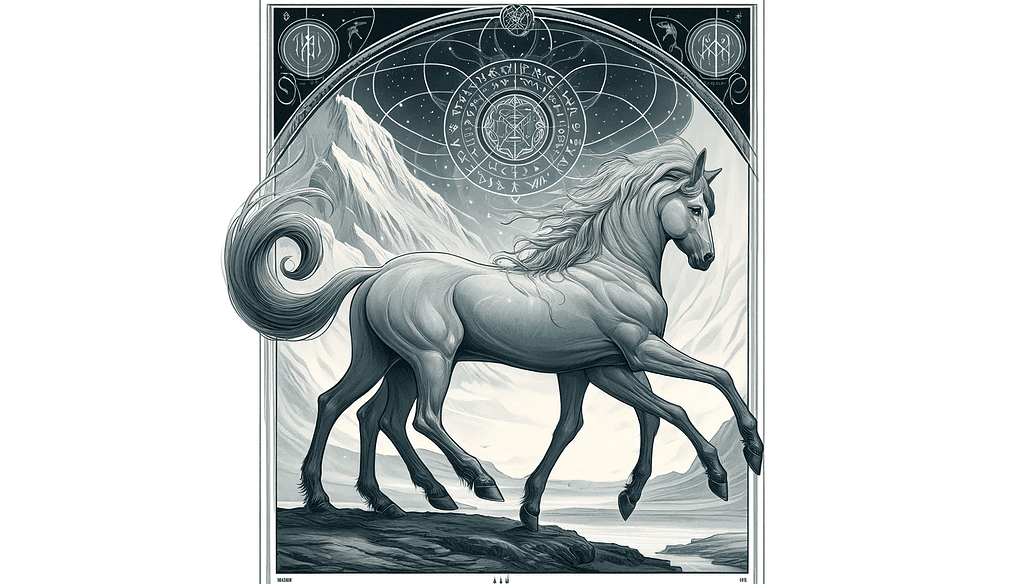
Sleipnir, the eight-legged horse of Odin, is renowned not only for his unmatched speed but also for his extraordinary ability to traverse the Nine Realms of Norse cosmology. This capability extends beyond mere physical movement; it reflects a profound connection to the spiritual and mystical aspects of Norse beliefs.
His eight legs, more than just a symbol of swift transportation, signify his mastery over the complexities of the cosmos, enabling him to move through different dimensions and the spaces between worlds. This unique attribute positions Sleipnir as a key figure in navigating the challenges and mysteries of the Norse universe.
The relationship between Sleipnir and Odin is central to understanding both characters’ roles in Norse mythology. As the steed of Odin, Sleipnir is not just a means of transport but also a companion in Odin’s quests for knowledge and wisdom.
Odin, often depicted as a wanderer and seeker of deeper truths, relies on Sleipnir’s abilities to carry him across the realms, facilitating his divine missions. This partnership is emblematic of the bond between the god and his horse, reflecting their mutual dependence in the pursuit of cosmic balance and understanding.
Together, Sleipnir and Odin traverse the metaphysical landscapes of the Norse world, exploring its depths and secrets. Sleipnir’s role extends beyond that of a mere vehicle; he is an integral part of Odin’s explorations and a symbol of the god’s power over the spiritual and the earthly.
This connection underscores the mythical horse’s significance not only in terms of mobility but also as a creature embodying the mystical linkage between the various facets of existence in the old Norse belief system.
Through their journeys, Sleipnir and Odin exemplify the interplay of knowledge-seeking and the overcoming of barriers, both physical and metaphysical, that define much of Norse mythology’s exploration of the universe.
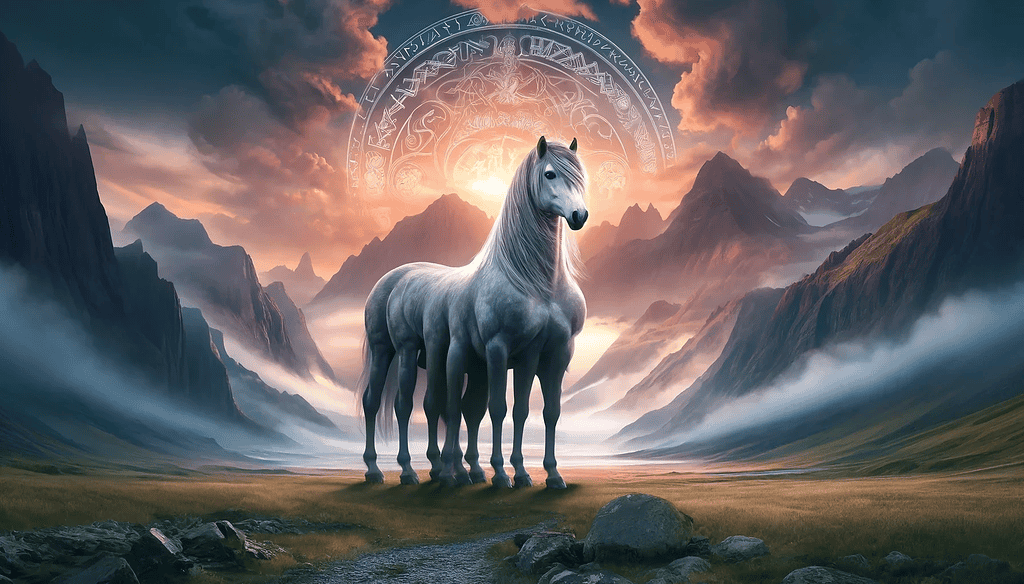
Sleipnir, Odin’s eight-legged steed, plays a pivotal role in the sagas of Norse mythology, facilitating the Allfather’s travels across the mythical landscapes. One of the most notable tales involves Odin’s ride to Hel, the realm of the dead, to seek wisdom regarding the fate of his son Baldr.
Sleipnir’s unique abilities allowed Odin to safely traverse the perilous path to Hel, demonstrating his importance not merely as a mode of transportation but as an essential ally in Odin’s quests. This story, among others, highlights Sleipnir’s integral role in navigating the challenges posed by the various realms, from the icy stretches of Jotunheim to the mystical depths of Hel.
In the grand narrative of Ragnarök, the prophesied end of the world, Sleipnir’s role is subtly but significantly mentioned. While Sleipnir himself is not at the forefront of the battle scenes, his duty in carrying Odin to the battlefield underscores his undying loyalty and his critical role in the unfolding events.
Sleipnir’s involvement in such crucial moments of Norse mythology highlights his status not just as a creature of speed and strength, but as a symbol of endurance and resilience in times of cosmic upheaval.
Additionally, Sleipnir is featured in lesser-known myths where he assists other gods and heroes in their adventures. For instance, the god Hermod rides Sleipnir on a perilous journey to negotiate Baldr’s release from Hel, further emphasizing the horse’s significance in the mythological narratives.
Through these tales, Sleipnir is portrayed as more than Odin’s steed; he is a heroic figure in his own right, capable of facing the immense challenges that define the ancient Norse cosmos.
These stories enhance our understanding of Sleipnir’s multifaceted role in Norse lore, portraying him as a bridge between the realms and a steadfast companion in the epic tales of gods and heroes.
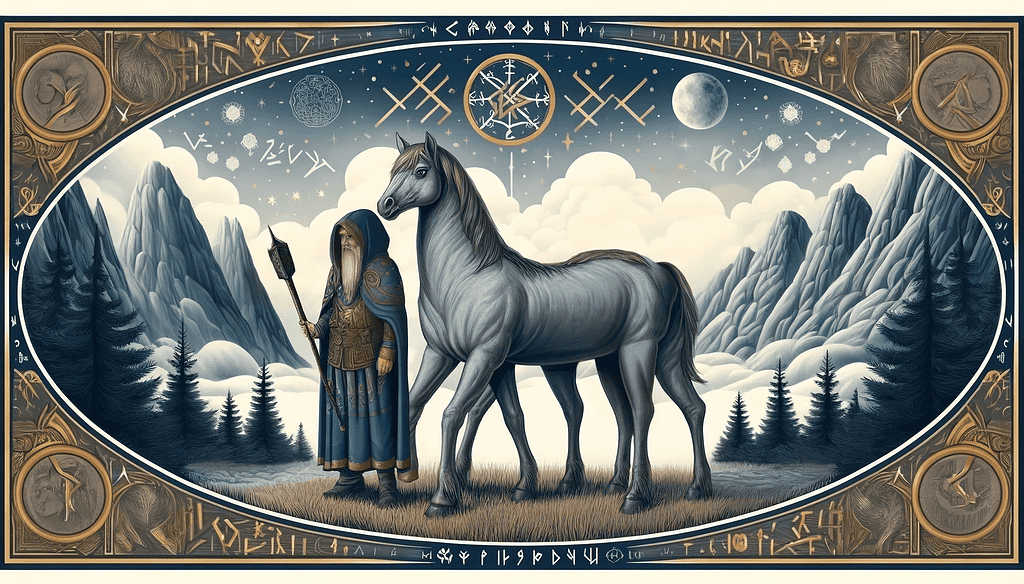
In the tapestry of Norse mythology, one event that vividly highlights the intertwined destinies and the competitive nature of the gods and their creatures is the legendary race between Odin on Sleipnir and the giant Hrungnir on his steed Gullfaxi. This race is not merely a test of speed but a profound demonstration of the powers attributed to these mythical beings.
Odin, the Allfather of the Norse gods, often sought to prove the might and virtue of his possessions and allies. Sleipnir, his eight-legged horse, was renowned across the nine realms for his unmatched speed and ability to traverse dimensions.
On the other side was Hrungnir, one of the strongest of the giants, whose horse Gullfaxi was also celebrated for its swiftness and strength. The race was initiated by Hrungnir, who boasted that his horse could outrun any in Asgard, leading to a challenge from Odin.
As the race commenced, it quickly became clear that Sleipnir was no ordinary steed. With Odin at the reins, Sleipnir moved with such agility and speed that he seemed to be flying across the land, effortlessly outpacing Gullfaxi. The outcome was significant, not only proving Sleipnir’s supremacy but also affecting the pride of Hrungnir.
Unable to accept his defeat gracefully, Hrungnir was incited to further rashness—he ended up in Asgard, where his drunken antics led to a duel with Thor, the god of thunder.
This confrontation resulted in Hrungnir’s death, a significant event that underscored the deadly seriousness of challenges among the divine and mythical beings of Norse lore.
This race is emblematic of the broader themes in Norse mythology, including the importance of proving one’s honor and the often fatal intertwining of pride and challenge among the gods and giants.
Sleipnir’s victory in this race not only emphasizes his extraordinary capabilities but also illustrates how the actions and contests of mythical creatures could directly influence the course of events within the pantheon, shaping the complex relationships and dramatic narratives that define Norse mythology.
Sleipnir, the eight-legged horse of Odin, has been a prominent figure in art and literature throughout the ages, encapsulating the mystical essence of Norse mythology. Ancient carvings, such as those found on the Gotland stones in Sweden, depict Sleipnir in a majestic form, emphasizing his role as a divine steed capable of moving between worlds.
These carvings not only celebrate his physical attributes but also signify his importance in the spiritual journeys of the gods. In literary terms, Sleipnir appears in seminal texts like the Poetic Edda and the Prose Edda, where his narratives are woven into the lore of the Norse gods, portraying him as an integral part of Odin’s adventures across the nine realms.
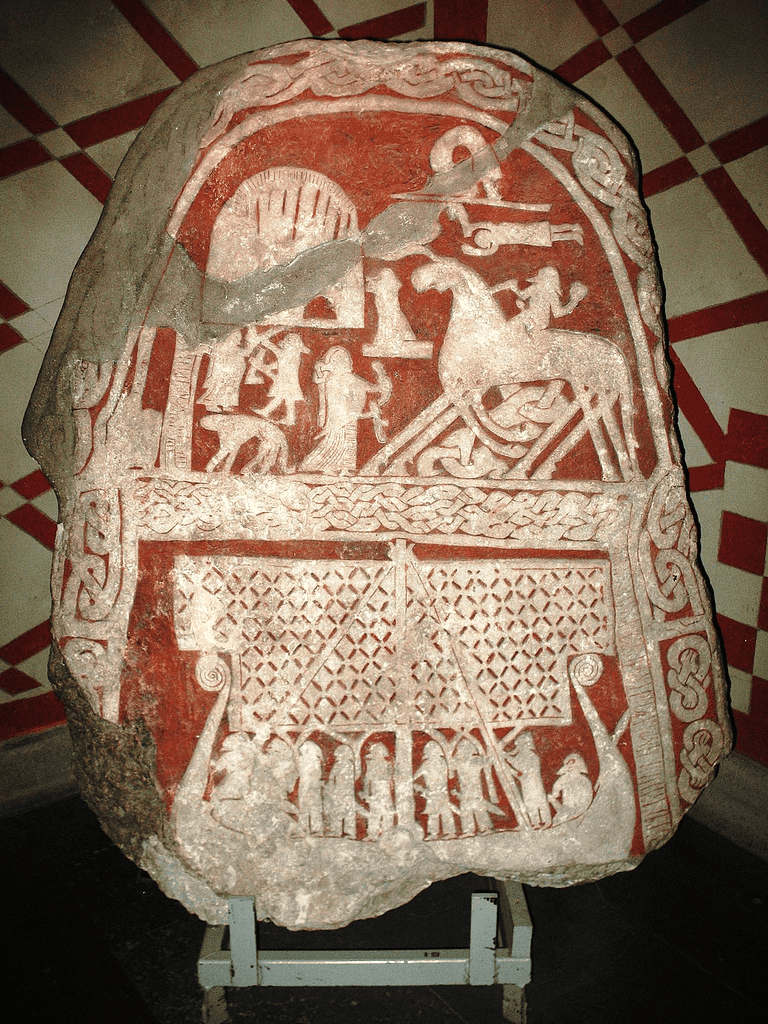
Don’t mind my shameless self-promotion! This bespoke pendant is handcrafted (by me) to order:
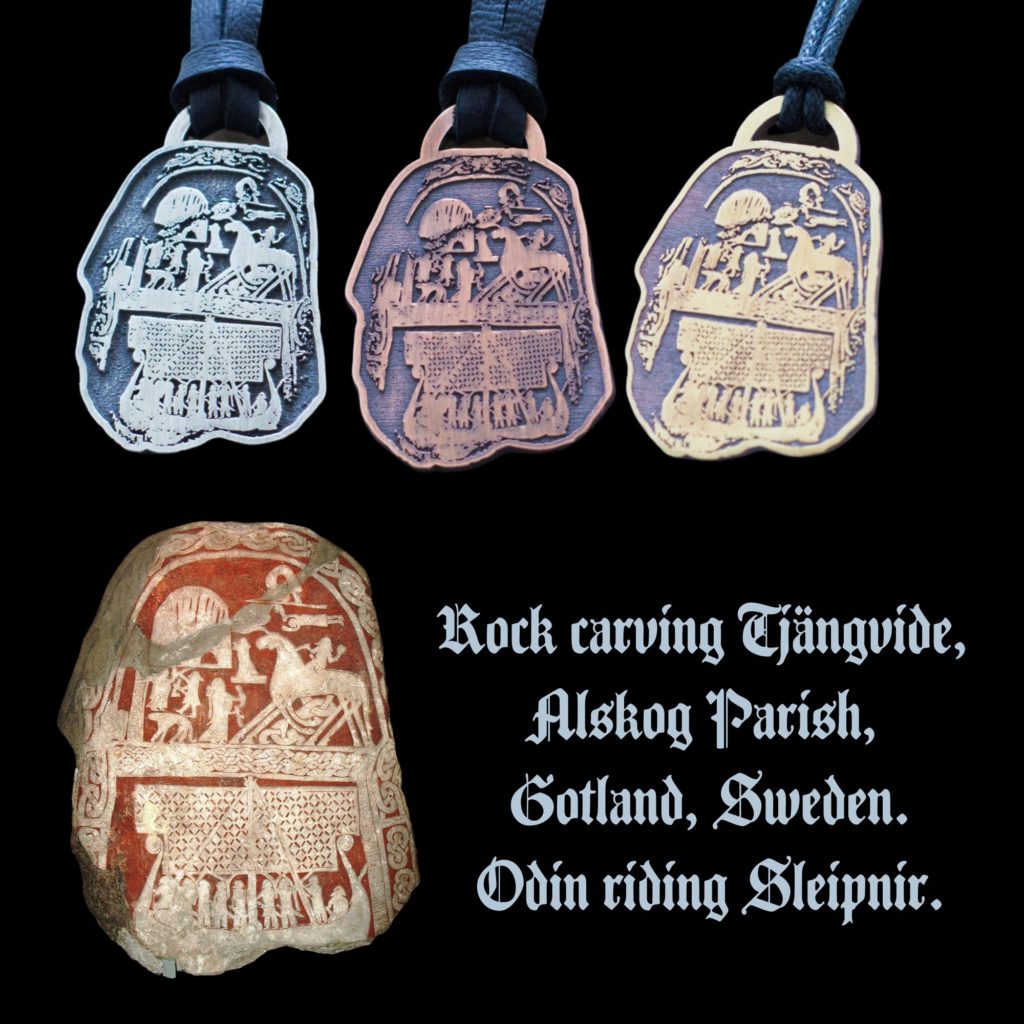
Throughout this exploration, Sleipnir’s role in Norse mythology has been illuminated, revealing not only his remarkable attributes as the eight-legged steed of Odin but also his profound impact on Norse cultural and spiritual life.
His abilities to traverse the nine realms and his symbolic significance in ancient art and modern media highlight his enduring appeal. Sleipnir’s story, from mythical narratives to contemporary interpretations, continues to inspire and captivate, bridging ancient mythology with modern fascination.
This journey through Sleipnir’s tale reaffirms his place as a quintessential figure in Norse lore, resonating with themes of power, loyalty, and transcendence.